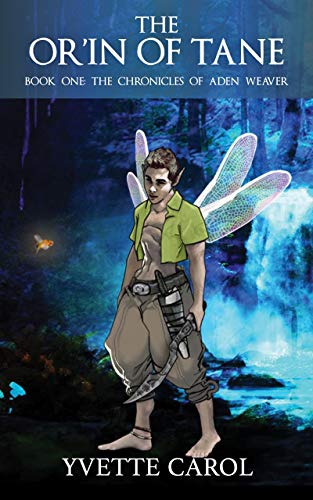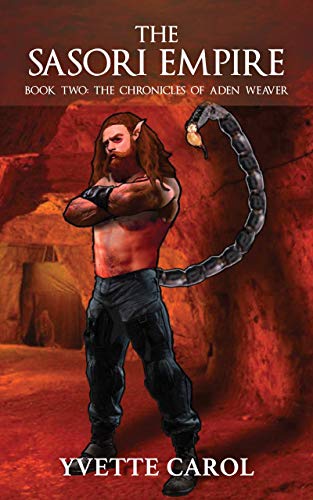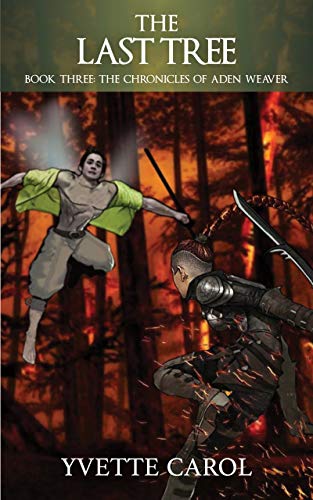

Yvette Carol’s enduring love of mythology and fantasy fiction for children inspired her to write her novels, The Or’in of Tane, and The Sasori Empire, and The Last Tree in the trilogy, The Chronicles of Aden Weaver. A former journalist, Yvette had an article published in the book, The Insecure Writer’s Support Group Guide to Publishing and Beyond for 2014, and a short story released in the 2015 children’s anthology, Kissed by an Angel. She lives with her family in Auckland, New Zealand, working on the next adventure.
1. Tell us a bit about yourself! Where do you call home and what do you write?
My name is Yvette Carol. I’m a full-time mum who has always written on the kitchen table, fitting in the stories around raising my three sons. I’m based in Auckland and I write middle grade epic fantasy.
2. What drew you to that particular genre and age group?
I felt myself drawn irresistibly to write epic fantasy because that was the genre I loved to read as a child. I’ve always written fantasy adventure for children, however, I’ve tried different age groups and styles. I started out as a seventeen-year-old writing early reader chapter books for 6 to 9-year-olds and then I illustrated and wrote picture books. But when I tried my hand at middle grade, the 9-13 age range, I felt I was in the right place at the right time. I had found my wheelhouse.
3. What’s your best known work?
The Chronicles of Aden Weaver
4. What inspired you to write it?
I took a “Writing for Children” course with Kate De Goldi in 2005. Kate taught us to do ten minutes “free writing” every day. She was big on character development and taught us to get to know our characters like old friends. We had to interview our cast of characters, keeping a notebook on everything about them from their appearance to their family history, questioning them about what they like, what they hate, their strengths, their flaws, and so on. When I started the discipline of daily free writing, armed with my character development, the characters told me the story, a little at a time over the course of five years.
My sisters and nieces and I used to get together regularly when our kids were preschoolers for a long lunch or “Aunties lunch”. One day, I was telling the girls about the story I was writing. My niece who is part-Maori said, “That sounds like the myth of Rata and Tane. Our nanny used to tell us myths...” and she regaled us with the word-of-mouth version. That was the moment I felt this story had landed. It had “legs” and it was going somewhere.
5. Tell us about your writing process. Are you a plotter, panster or somewhere in between? How do you research? Do you research upfront or dive right in and Google as you go?
I’m a pantser. For The Chronicles of Aden Weaver, I had the rough draft for all three books written after five years but it took me a further ten years to craft individual plots for each story and figure out all the intricate details like character arcs and story lines for each one. I end up like a mad scientist or inventor cooped away in my tower, hammering and welding pieces together from here, there and everywhere, then messing with my creation endlessly until somehow out of the chaos arises a phoenix.
As for research, I do this as I go and according to what I need.
6. What’s the strangest or most interesting thing you’ve researched for your writing?
We researched the official version of the myth of Rata and Tane held at Auckland Library. It was more or less the same as the oral version. My niece felt it was fine to change the myth as I wanted to for my story, but I didn’t feel entirely comfortable with the idea. So, I set the entire series in an alternate universe, on the planet Chiron, peopled by insects and shapeshifters. Then I felt free to change Chief Rata to Chief Kal, and I changed the wood chip in the myth to a stone (the Or’in of Tane).
7. What’s the most personal story/scene you’ve written and why?
That’s an interesting question! I would have to say the attack scene in Book One, The Or’in of Tane. *Spoiler alert if you haven’t read Book One!* In one of the scary scenes, the enemy agents tailing our hero, Aden Weaver, ambush him in his garden and then attack Aden’s beloved grandparents, who rush to his aid.
This brings me to a secret no one else knows. During the time I was editing The Or’in of Tane with the help of American author and editor, Maria Cisneros-Toth, I originally had Nana Jeen and Papa Joe die at the end of Book One. But when Maria and I started editing Book Two, The Sasori Empire, Maria expressed resistance to learning that I had killed off Aden’s grandparents. She pleaded to save them. So I changed the story to Nana Jeen and Papa Joe surviving the attack of Book One. This decision worked out really well as the grandparents had a nice minor role to play in Book Three, tutoring Aden in the mythology of the Land of Fire and Ice before he and his team left on their mission.
Grandparents are always a feature in my stories somewhere. I revere the older generation. As I missed out on having grandparents around when I was growing up, I love to put grandparents in my fiction and give myself the therapy of experiencing grandparents through my characters. So, for me, during the original writing of that scary scene in Book One when the enemy agents beat Nana Jeen and Papa Joe, I thought it was the grandparents’ death scene therefore the emotions Aden felt going through this terrifying experience reflected the severity of the situation. Every time I read that part of The Or’in of Tane, I feel moved.
8. Who are your literary influences? In what way?
As a child, I loved The Chronicles of Narnia by C. S. Lewis because of his fabulous imagination. New worlds and concepts always drew me to fantasy fiction. My mother and sisters were fans of the Moomintroll series of books by Tove Jansson. I would take out one of the Moomin books from the school library at a time and savour them. Tove was inspirational with her masterful world building and nonhuman cast. She deeply influenced my thinking about creative fiction. Tove offered glimpses, sneak peeks beyond the fetters of this life, and that is the secret message that is so beautiful and empowering to pass onto children. There is more. Open your hearts and minds and expand the possibilities.
I love the empowerment that forms the core of children’s literature. When I approached writing my first story, I did so with a sense of limitlessness. I didn’t feel my characters needed to be human for me to care about them.
In more recent decades Brian Jacques has been an enormous influence, specifically the Redwall series, which author Lorraine Orman recommended I read about twenty years ago. When Lorraine learned of my bent towards anthropomorphic characters, she suggested I read the Redwall books as no one did anthropomorphic stories better. So I started reading them then and I’ve loved them ever since. Jacques is my hero!
9. What books are on your bedside table right now?
My latest acquisitions and closest to the top of the pile for reading next are Fifteen Postcards by Kirsten McKenzie, Faerie Lights by Andie Low, Fire & Shadow by T.G. Ayer, and The Phantom Tollbooth by Norton Juster.
10. Last and most important, where can we find your stories?
Follow Yvette on these platforms!
Liked this interview? Sign up to Nikky's mailing list to get more updates, articles and interviews delivered straight to your inbox!






Comments